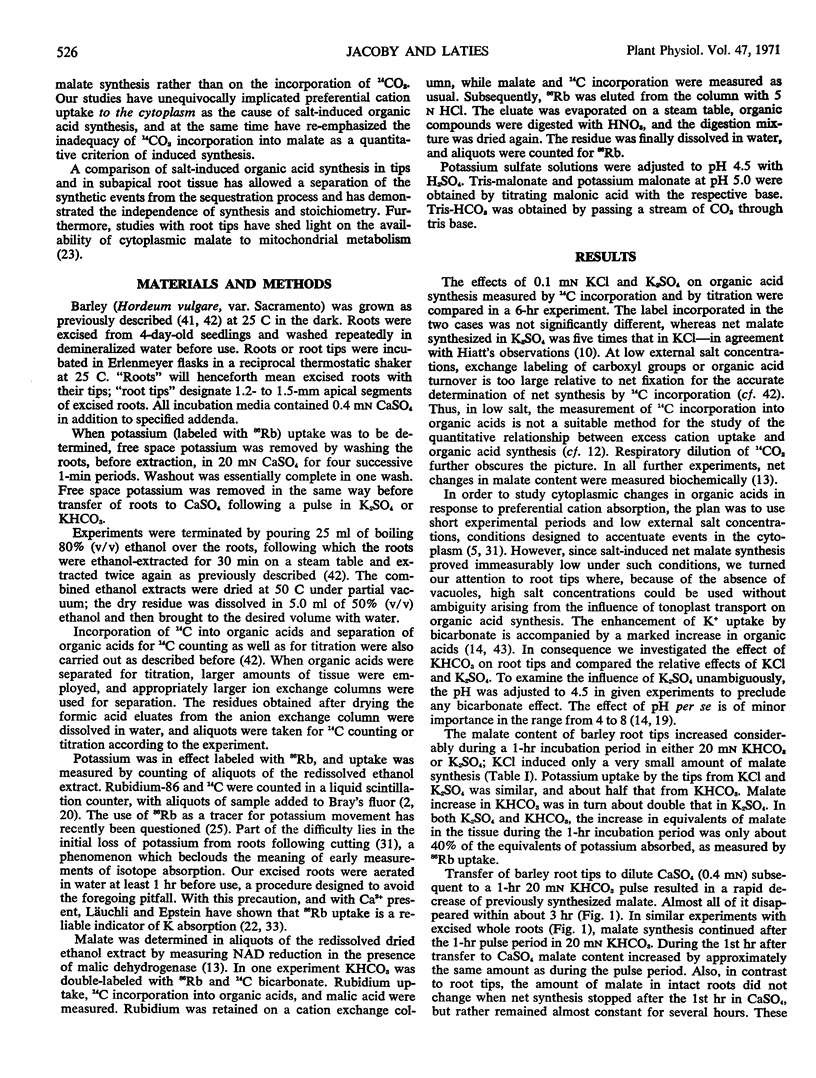Abstract
The relationship of malate synthesis to K+ absorption from solutions of K2SO4 and KHCO3 was compared in nonvacuolate barley (Hordeum vulgare) root tips and whole excised roots. The comparison has permitted separation of the process which evokes organic acid synthesis from that which leads to stoichiometry between net acid equivalents formed and excess K+ absorbed from K2SO4, on the one hand, and total K+ absorbed from KHCO3, on the other. Both in tips and in roots K+ uptake from 20 mN salt solution exceeds malate synthesis in the first hour. In vacuolate roots the expected stoichiometry is achieved with time. When root tips are transferred to dilute CaSO4, malate is rapidly metabolized, and K+ is lost to the solution. By contrast, in excised whole roots the malate level remains unchanged, the salt-induced organic acid presumably being retained in the vacuole. In excised roots malonate leads to a marked drop in malate levels in untreated roots as well as in roots which have experienced salt-induced net malate synthesis. In consequence, it is contended that malonate makes available normally sequestered vacuolar malate.
The general hypothesis is offered that the bicarbonate level of the cytoplasm controls organic acid synthesis by phosphoenolpyruvate carboxylase, and that the cytoplasmic bicarbonate level is raised either by exchange of cytoplasmic H+ for external cation, or by bicarbonate absorption directly. Stoichiometry, in turn, is achieved by the accumulation in the vacuole of the double salt of malate.
Full text
PDF






Selected References
These references are in PubMed. This may not be the complete list of references from this article.
- Cooper T. G., Tchen T. T., Wood H. G., Benedict C. R. The carboxylation of phosphoenolpyruvate and pyruvate. I. The active species of "CO2" utilized by phosphoenolpyruvate carboxykinase, carboxytransphosphorylase, and pyruvate carboxylase. J Biol Chem. 1968 Jul 25;243(14):3857–3863. [PubMed] [Google Scholar]
- Cram W. J. Short term influx as a measure of influx across the plasmalemma. Plant Physiol. 1969 Jul;44(7):1013–1015. doi: 10.1104/pp.44.7.1013. [DOI] [PMC free article] [PubMed] [Google Scholar]
- Dalziel K., Londesborough J. C. The mechanisms of reductive carboxylation reactions. Carbon dioxide or bicarbonate as substrate of nicotinamide-adenine dinucleotide phosphate-linked isocitrate dehydrogenase and malic enzyme. Biochem J. 1968 Nov;110(2):223–230. doi: 10.1042/bj1100223. [DOI] [PMC free article] [PubMed] [Google Scholar]
- Danner J., Ting I. P. CO(2) Metabolism in Corn Roots. II. Intracellular Distribution of Enzymes. Plant Physiol. 1967 May;42(5):719–724. doi: 10.1104/pp.42.5.719. [DOI] [PMC free article] [PubMed] [Google Scholar]
- Jacobson L. Carbon Dioxide Fixation and Ion Absorption in Barley Roots. Plant Physiol. 1955 May;30(3):264–269. doi: 10.1104/pp.30.3.264. [DOI] [PMC free article] [PubMed] [Google Scholar]
- Jacobson L., Ordin L. Organic Acid Metabolism and Ion Absorption in Roots. Plant Physiol. 1954 Jan;29(1):70–75. doi: 10.1104/pp.29.1.70. [DOI] [PMC free article] [PubMed] [Google Scholar]
- Lips S. H., Beevers H. Compartmentation of Organic Acids in Corn Roots II. The Cytoplasmic Pool of Malic Acid. Plant Physiol. 1966 Apr;41(4):713–717. doi: 10.1104/pp.41.4.713. [DOI] [PMC free article] [PubMed] [Google Scholar]
- Maas E. V., Leggett J. E. Uptake of rb and k by excised maize roots. Plant Physiol. 1968 Dec;43(12):2054–2056. doi: 10.1104/pp.43.12.2054. [DOI] [PMC free article] [PubMed] [Google Scholar]
- Maclennan D. H., Beevers H., Harley J. L. 'Compartmentation' of acids in plant tissues. Biochem J. 1963 Nov;89(2):316–327. doi: 10.1042/bj0890316. [DOI] [PMC free article] [PubMed] [Google Scholar]
- Maruyama H., Easterday R. L., Chang H. C., Lane M. D. The enzymatic carboxylation of phosphoenolpyruvate. I. Purification and properties of phosphoenolpyruvate carboxylase. J Biol Chem. 1966 May 25;241(10):2405–2412. [PubMed] [Google Scholar]
- Osmond C. B., Laties G. G. Compartmentation of malate in relation to ion absorption in beet. Plant Physiol. 1969 Jan;44(1):7–14. doi: 10.1104/pp.44.1.7. [DOI] [PMC free article] [PubMed] [Google Scholar]
- Osmond C. B., Laties G. G. Interpretation of the dual isotherm for ion absorption in beet tissue. Plant Physiol. 1968 May;43(5):747–755. doi: 10.1104/pp.43.5.747. [DOI] [PMC free article] [PubMed] [Google Scholar]
- Steward F. C., Preston C. EFFECTS OF pH AND THE COMPONENTS OF BICARBONATE AND PHOSPHATE BUFFERED SOLUTIONS ON THE METABOLISM OF POTATO DISCS AND THEIR ABILITY TO ABSORB IONS. Plant Physiol. 1941 Jul;16(3):481–519. doi: 10.1104/pp.16.3.481. [DOI] [PMC free article] [PubMed] [Google Scholar]
- Ting I. P. CO(2) Metabolism in Corn Roots. III. Inhibition of P-enolpyruvate Carboxylase by l-malate. Plant Physiol. 1968 Dec;43(12):1919–1924. doi: 10.1104/pp.43.12.1919. [DOI] [PMC free article] [PubMed] [Google Scholar]
- Ting I. P., Dugger W. M. CO(2) Metabolism in Corn Roots. I. Kinetics of Carboxylation and Decarboxylation. Plant Physiol. 1967 May;42(5):712–718. doi: 10.1104/pp.42.5.712. [DOI] [PMC free article] [PubMed] [Google Scholar]
- Torii K., Laties G. G. Dual mechanisms of ion uptake in relation to vacuolation in corn roots. Plant Physiol. 1966 May;41(5):863–870. doi: 10.1104/pp.41.5.863. [DOI] [PMC free article] [PubMed] [Google Scholar]
- WALKER D. A., BROWN J. M. Physiological studies on acid metabolism. 5. Effects of carbon dioxide concentration on phosphoenolpyruvic carboxylase activity. Biochem J. 1957 Sep;67(1):79–83. doi: 10.1042/bj0670079. [DOI] [PMC free article] [PubMed] [Google Scholar]


